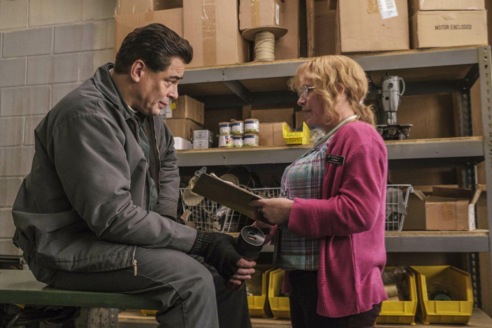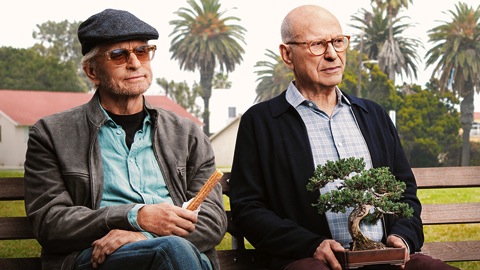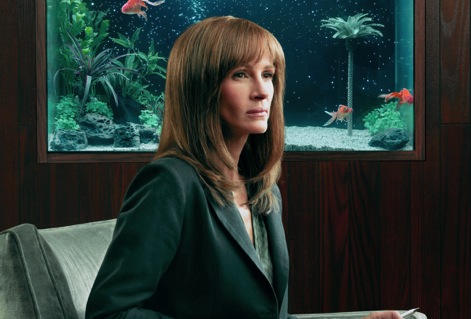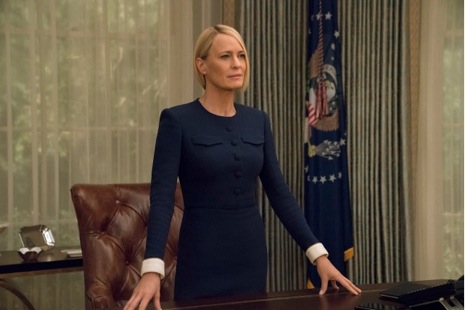Nov 2018
Showtime's Escape At Dannemora: A prison break quite unlike any other from a guy who'd been comedic all the way
11/16/18 09:19 AM

Benicio Del Toro and Patricia Arquette play co-conspirators in Escape At Dannemora, based on a 2015 New York State prison break. Showtime photo
Premiering: Sunday, Nov. 18th at 9 p.m. (central) on Showtime
Starring: Benicio Del Toro, Patricia Arquette, Paul Dano, Eric Lange, Bonnie Hunt, David Morse
Directed by: Ben Stiller
Produced by: Ben Stiller, Brett Johnson, Michael Tolkin, Michael De Luca, Bryan Zuriff, Nicholas Weinstock, Bill Carraro
By ED BARK
@unclebarkycom on Twitter
There’s nothing at all comedic, or even serio-comic about Showtime’s Escape At Dannemora, which makes it all the more surprising to see Ben Stiller’s named attached as the director and principal executive producer of all seven episodes.
His previous directorial effort, 2016’s Zoolander 2, in which Stiller also co-starred, makes this quite a segue for the erstwhile madcap son of comedians Jerry Stiller and the late Anne Meara. But here we are, and Ben Stiller for the most part has pulled this off.
Showtime made the entire limited series available for review, and it could benefit from a quickened pace and shorter length. Dannemora at times can seem like a life sentence for viewers, although its grit, realism and performances (particularly by Patricia Arquette and Eric Lange) are major selling points throughout. Almost all of the filming was done on location in a concerted effort to “tell a true story in as real a way as possible,” according to network publicity materials.
Based on a real-life 2015 escape from the maximum security Clinton Correctional Facility in upstate Dannemora, NY, the events within take up far more space than what happens beyond the walls. It’s not until the end of Episode 5 that convicted murderers Richard “Hacksaw” Matt (Benicio Del Toro) and David Sweat (Paul Dano) pull off the first getaway in the prison’s 170-year history. Episode 6 then executes quite a twist before the expanded 1 hour, 39 minute finale details what became of Matt and Sweat. (Come to think of it, that kind of sounds like a comedy team.)
Del Toro and Dano are both solidly believable, but the bravura performances in Dannemora come from Arquette and Lange as prison employees who get to taste freedom daily, even if it mostly tastes pretty sour.
Arquette, who won an Emmy for her starring role in NBC’s Medium and an Oscar for her acting in 2014’s Boyhood, is barely recognizable as plain, lumpy Joyce “Tilly” Mitchell. She fully inhabits the role of a prison tailor shop supervisor who succumbs to the sexual seductions and promises of both Sweat and Matt. In return, Tilly smuggles in some of the means for their eventual escape with help from enabling guard Gene Palmer (David Morse), who’s become close with Matt and cherishes the sketches and portraits drawn for him to take home.
Tilly’s husband, Lyle (Lange), is a well-meaning slug who yearns to make his wife happy and appreciative while she increasingly spurns him. Together they’re both pathetic and (very) oddly endearing, making ends barely meet in their hovel of a home. A big night out is dinner at a nearby Chinese restaurant followed by Blizzards at Dairy Queen. Both Arquette and Lange craft these roles beautifully. And at the end of Episode 6, the lingering closeup of her satisfied (for now) countenance is one of the best such shots in TV history.
Meanwhile, the planned escape proceeds at a sub-snail’s pace, with Sweat doing all of the dirty, arduous digging and tunnel-crawling in claustrophobic spaces that eventually will lead somewhere. Matt strives to keep him motivated. “For once in our lives, we’re winning,” he exudes.
Episode 5 begins with a meticulously crafted practice run set to a bongo beat. It’s a tour de force from a filmmaking standpoint, taking roughly nine minutes to complete from start to finish. Whether some viewers might grow antsy is another matter. Be assured, though, that you’ll be seeing something quite unique.
Prison dramas have made strong and enduring impressions over the years, including HBO’s Oz and the feature films Cool Hand Luke, The Shawshank Redemption, Birdman of Alcatraz, The Longest Yard and Dead Man Walking.
Escape At Dannemora doesn’t rise to the top of this formidable list, but may someday belong in the discussion. Stiller, for his part, has freed himself from the shackles of comedy and proven that he may well be able to do just about anything.
GRADE: B+
Email comments or questions to: unclebarky@verizon.net
Michael Douglas, Alan Arkin keep their zip in Netflix's The Kominsky Method
11/15/18 03:11 PM

Michael Douglas & Alan Arkin time-share in The Kominsky Method. Netflix photo
Premiering: All eight Season One episodes begin streaming Friday, Nov. 16th on Netflix
Starring: Michael Douglas, Alan Arkin, Nancy Travis, Sarah Baker, Lisa Edelstein, Susan Sullivan, Emily Osment, Graham Rogers, Ashleigh LaThrop, Jenna Lyn Adams, Melissa Tang, Casey Brown
Produced by: Chuck Lorre, Michael Douglas
By ED BARK
@unclebarkycom on Twitter
Netflix has become a powerful streamer. Michael Douglas’ new character very much wants to be one again.
Symmetry is where you find it in The Kominsky Method, which devotes much of its third and fourth episodes to the joyless onslaught of frequent trickle-peeing courtesy of enlarged prostates. So yes, this eight-episode Netflix comedy from ace producer Chuck Lorre (The Big Bang Theory, Two and a Half Men) draws its strength from the travails of two advanced agers. Douglas, 74, plays respected acting coach Sandy Kominsky and Alan Arkin, 84, is his longtime agent and best friend, Norman Newlander. They crackle together, with Arkin in particular taking grousing and griping to new levels. A major death in the family (we won’t say who or when) can do that to you, although Norman already had been in a league of his own.
Netflix made all eight Season One episodes available for review. They generally run closer to 30 minutes than 20 minutes each, but not always. Which makes bingeing the whole thing in one sitting a do-able proposition -- rest room trips included.
Douglas wears his hair long and his stubble proudly as mentor to a group of mostly young students, save for one. Lisa (Nancy Travis) is considerably closer in age and therefore both suitable and susceptible in terms of Sandy’s other interests. She’s recently divorced and he has three exes. Where the series goes with their relationship is consistently refreshing and “adult” during what’s been quite a year for Travis’ under-appreciated talents. She’s also currently playing Tim Allen’s wife on Fox’s Last Man Standing and co-stars in the Audience network’s Mr. Mercedes series.
Kominsky Method is more a bromance, though, even with Norman’s savy, salty wife, Eileen (Susan Sullivan), also long by his side. The two men still dine regularly at Hollywood’s ancient Musso & Frank’s eatery, where Norman sips martinis and Sandy has his Jack Daniels/Dr. Pepper concoction while a barely ambulatory waiter shuffles to and from their regular table.
Their first bit of banter, a variation on the old Abbott & Costello “Who’s on First?” routine, is built around the rapper/actor Ludacris. It’s too labored to work very well, but they soon get on the same page even while seldom agreeing on much of anything. Arkin is a cinch Emmy nominee for his contributions and Douglas may well find himself along for that ride.
The scenes with the acting class students for the most part don’t work as well. Sandy and his formerly estranged daughter Mindy (nice work by Sarah Baker) run The Kominsky Method studio in a nurturing fashion that could use a little more edge. Henry Winkler, who recently won his first Emmy as an acting coach in HBO’s Barry, was a more vividly rendered character with a bombastic temper fueled by delusions of grandeur. Sandy can get exasperated at times, particularly with a broadly drawn male goofball blonde named Jude (Graham Rogers). But he’s mostly simpatico -- and maybe too much so.
The series is sautéed with brief appearances by familiar performers, some of whom play themselves (Elliott Gould, Patti LaBelle, Jay Leno, Eddie Money) and others as someone else (Ann-Margret, Danny DeVito). Lisa Edelstein recurs as Norman’s drug/alcohol-addicted daughter, Phoebe, for whom he has no patience but occasional remorse for being that way with her.
Producer Lorre’s Young Sheldon, now in its second season, was his first comedy series shorn of a live studio audience and accompanying laugh track. It looks as though he’s still learning the “single-cam” rhythms at times, with some of the give-and-take in Kominsky Method feeling as though it’s waiting on an audible audience response. Still, the series hits its stride soon enough. Episodes 5 and 6 are particularly strong, whether it’s Sandy getting all dressed up to do a reverse mortgage commercial or Norman saying in all seriousness, “If you look at it objectively, my continued existence is pointless.”
Viewers of a certain age may well respond with knowing head nods to the age-old predicaments that Sandy and Norman find themselves in. But the series might also have some traction with advertiser-prized 18-to-49-year-olds. For whatever reasons, they’ve made Last Man Standing and Fox’s following The Cool Kids (which is set in a retirement home) Friday night’s two most popular broadcast network series among viewers in this demographic. Perhaps frequent urination is the new comedy gold?
Kominsky Method ends with plenty of room for a second season. And why not? Netflix has gotten considerable mileage out of its other seniors gone wild comedy, Grace and Frankie. Its core cast of 80-year-old Jane Fonda, Lily Tomlin (79), Martin Sheen (78) and Sam Waterston (78) is by far the oldest in TV or streaming history. Their numbers are up. But as Douglas and Arkin prove anew, old pros are still capable of shifting into gear and then humming along despite all those incumbent aches, pains and spikes in bathroom breaks.
GRADE: B+
Email comments or questions to: unclebarky@verizon.net
Amazon Prime's Homecoming has both star power and a story that sticks
11/01/18 03:58 PM

Premiering: All 10 episodes begin streaming Friday, Nov. 2nd on Amazon Prime
Starring: Julia Roberts, Stephan James, Bobby Cannavale, Shea Whigham, Sissy Spacek, Alex Karpovsky, Marianne Jean-Baptiste, Dermot Mulroney, Jeremy Allen White
Produced by: Sam Esmail, Julia Roberts, Chad Hamilton, Eli Horowitz, Micah Bloomberg, Alicia Van Couvering, Alex Blumberg, Matt Lieber, Chris Gilibert
By ED BARK
@unclebarkycom on Twitter
A plus-sized pelican emitting growling sounds seems to know something’s fishy about the “reintegration process” at Florida’s Homecoming Transitional Support Center.
It’s supposed to be a place where traumatized war veterans get the help they need for gainful returns to civilian lives. But what’s the real purpose of the medications and interview sessions with case workers such as Heidi Bergman? Efficiently and then affectingly played by Julia Roberts, she’s her own case study in terms of the power of susceptibility. Seldom if ever satisfied is Heidi’s hard-charging boss, Colin Belfast (Bobby Cannavale), who rat-a-tat-tats directives via his cell phone. Both of their personal lives are basically beside the point.
Based on a same-named podcast, Amazon Prime’s Homecoming is a slowly developing but ultimately quite satisfying limited series that’s created, directed and co-produced by Sam Esmail. Its 10 episodes, all of them streaming Friday, Nov. 2nd on Amazon, range from just under or just over 30 minutes each. That’s an easy enough binge, and another three minutes or so can be shaved from each chapter by bypassing the fairly elongated closing credits.
Homecoming quickly turns out to be about both past and present. Because we also see Heidi as a waitress at a diner named Fat Morgan’s. One day she has a visitor, Department of Defense cog Thomas Carrasco (Shea Whigham). He has questions about her relatively brief tenure at the Homecoming center, but Heidi insists that she can’t remember a thing.
A framing device also comes into play. Most of the scenes from Heidi’s present are presented in a notably smaller vertical box while her caseworker past will fill your home screens. It’s a fail-safe way to separate the main character’s two lives and avoid any viewer confusion until things begin to meld back together down the stretch. Still, some might find this to be an irksome device.
Heidi’s featured patient at the Homecoming facility is Walter Cruz (Stephan James), who lost a close buddy in battle. He’s African-American and much younger than her. They make slow but steady progress in sorting out his psyche and their overall relationship. Then one day something doesn’t click for him, while it’s just the opposite for her.
Homecoming also has two other familiar faces. Dermot Mulroney plays Heidi’s live-in boyfriend, Anthony, during her time at Homecoming. Sissy Spacek is Heidi’s mother, Ellen, with whom she’s staying while toiling at the diner. Neither supporting role is of all that much consequence during this drama’s swervy roads to self-realization. Better rendered is Marianne Jean-Baptiste as Walter’s no bull mother, Gloria.
Some things don’t really add up, such as the cell phone that somehow remains charged after years of unuse. Or a getaway by Walter and a GI pal (Jeremy Allen White as Shrier) in which they drive on and on, it seems, without any conversation at all about why it’s taking so long just to find a place to have a beer.
But Homecoming also has considerable pulling power. Whigham’s portrayal of Carrasco is the most compelling. He provides a strong rooting interest as a dogged investigator who’s seen as just another nameless underling by his condescending boss (played by Brooke Bloom).
Roberts and Cannavale also contribute memorable characterizations while newcomer James makes Walter much more than a guinea pig.
These performances and a solidly intriguing story make Homecoming worth your down payment. Stay the course and you’ll get a nice payoff as well.
GRADE: B+
Email comments or questions to: unclebarky@verizon.net
House of Cards: the last shuffle
11/01/18 10:00 AM

By ED BARK
@unclebarkycom on Twitter
The man who is not there both haunts and hovers over the last term for Netflix’s game-changing House of Cards.
Specifically put, how did Francis Underwood die, after the man who played him, Kevin Spacey, killed his career?
Spacey, fired a year ago after multiple allegations of sexual misconduct, hasn’t been seen or heard from in public since that time. The character he left behind also is unseen in any form during the first five hours of this final and shorter eight-episode season, which begins streaming in its entirety on Friday, Nov. 2nd.
Francis Underwood otherwise is very much heard of. Not only from steely Claire Underwood (Robin Wright) but by a steady stream of loyalists, enemies and grovelers. It may be “My turn,” as Claire pronounced at the end of Season 5 after Francis bequeathed the presidency to her with the phony promise of a forthcoming pardon. But what he wrought -- and who or what did him in -- is still in the show’s blood as it grapples with and sometimes staggers through dense thickets of wanton conniving.
All of this is tied to the overriding mystery of whether Francis in fact died peacefully (ha!) in his sleep or was fast-forwarded toward those White House-approved still pictures of the widowed Claire (and she likes it like that) affecting a somber countenance at his funeral.
Many of the show’s familiar supporting characters, principally the supremely and pathetically dutiful Doug Stamper (Michael Kelly), are still plotting and being plotted against. But if that’s not enough strings being pulled, there also are two new antagonists, Bill Shepherd and his sister, Annette (Greg Kinnear, Diane Lane). They’re right-wing power brokers and industrialists modeled after the Koch brothers. And they want Claire to either be their puppet or be impeached to pave the way for toady vice president Mark Usher (Campbell Scott).
House of Cards also brandishes and embraces the #MeToo movement, but in ways that might be seen as counter-productive. A flashback to an early incident in her life (we’ll say no more) fuels Claire’s fires -- but not for the sake of principles. Throughout these first five episodes, she’s mostly determined to exact pure, unadulterated revenge on those who used to wear the pants -- but not pantsuits.
“Would you have asked me that if I were a man?” she bristles after addressing the troops during a Fourth of July rallying cry for her administration’s new aggression in Syria.
In Episode 2, Claire proclaims, “The reign of the middle-aged white man is over.” And in Episode 5, “Shall I resign for the high crime of being a female?”
But by the end of this hour, House of Cards is aces again, courtesy of a galvanizing and genuinely surprising gender-gone-wild twist. That’s meant as a compliment --story-wise at least -- although Claire’s motives remain the same. She’ll do whatever it takes to remain in power, including the murders she’s already authorized or committed herself. Claire is a feminist strictly on her own terms, with a long-acquired taste for the jugular. Perhaps a certain real-life sitting President would relish having someone like her as a running mate. Except that Claire would be calling the shots. All of them.
Emulating her late husband and de facto mentor, Claire also has taken to talking to the camera. During the re-juiced Episode 5, her seemingly darkest hours as President are no cause for worry. “Don’t worry I have a plan,” she assures living room onlookers.
Even so, House of Cards also can be a victim of its own excesses, which are now built up into a heavy goo of previous evil and investigations of same by the sometimes ridiculously dogged Tom Hammerschmidt (Boris McGiver). He’s the high-strung and at times wrung-out investigative reporter who’s still trying to piece together who killed former Washington Herald colleague Zoe Barnes (Kate Mara) near the start of Season 2.
House of Cards devotees certainly will remember that then shocking scene. Since then, what really shocks anymore? The betrayals, bed-hoppings, fatalities and misdirections have piled up to the point where basically no one has clean hands. In her particular case, Claire has long believed what she tells the camera in Episode 4: “Presidents aren’t allowed to be human. You have to choose: power or love. That was very clear from the beginning.”
She learned from the master. And Wright’s performance reflects all of her late husband’s cynicism, calculation and deep, unhealed wounds that powered his engine, and now hers as a President who pledges allegiance only to herself and her gender.
Francis Underwood is an accessory to all of House of Cards’ many crimes in this final season of divides and conquers. In the end, who will end up atop the Iron Throne? Oh wait, that’s another TV series. But this one seems no less bloody. And yes, it’s high time to put an end to it.
GRADE: B-minus
Email comments or questions to: unclebarky@verizon.net
